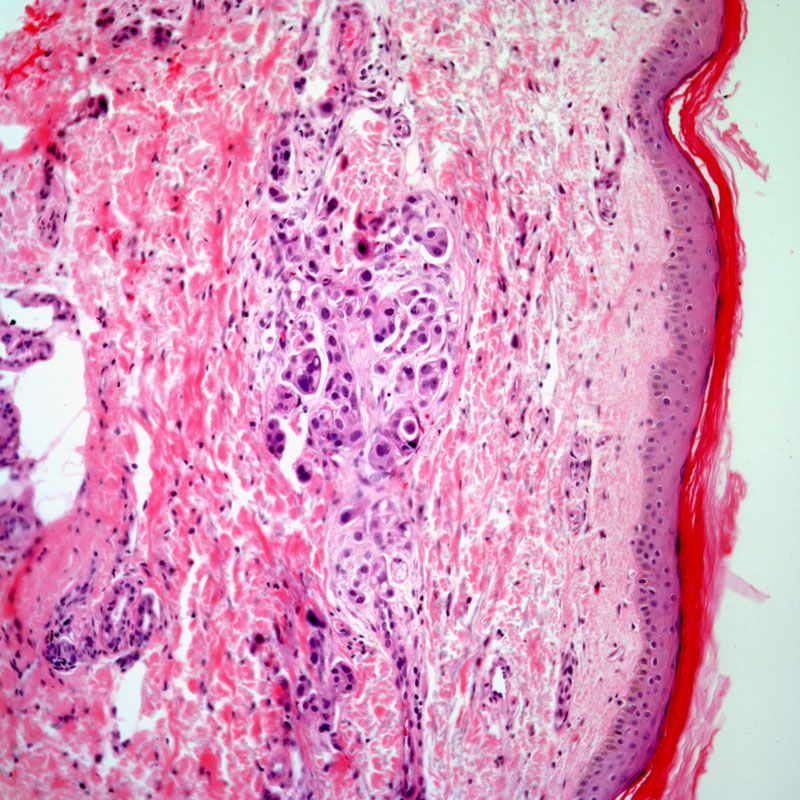Atezolizumab with Neoadjuvant Chemo Does Not Meet End Points in TNBC
Atezolizumab with chemotherapy did not yield a significant increase to event-free survival compared with placebo with chemotherapy, 85.2% vs 81.9%, respectively.
Atezolizumab with chemotherapy did not yield a significant increase to event-free survival compared with placebo with chemotherapy, 85.2% vs 81.9%, respectively.

For patients with triple-negative breast cancer (TNBC), the randomized, double-blind phase 3 NSABP B-59/GBG-96-GeparDouze (NCT03281954) found that atezolizumab (Tecentriq) plus neoadjuvant chemotherapy followed by adjuvant atezolizumab did not generate a statistically significant increase to event-free survival (EFS) when compared with placebo plus chemotherapy.
Results presented at the 2024 San Antonio Breast Cancer Symposium (SABCS) showed that at a median follow-up of 46.9 months, the 4-EFS rate was 85.2% (95% CI, 82.4%-87.7%) with atezolizumab/chemotherapy vs 81.9% (95% CI, 78.9%-84.6%) with placebo/chemotherapy, a difference that was not statistically significant (HR, 0.8; 95% CI, 0.62-1.03); P = .08). This lack of benefit was consistent across all patient subgroup except clinical nodal status, in which there was a significant difference favoring atezolizumab in patients with positive node status (P = .039).
There was no overall survival (OS) benefit with atezolizumab at 4 years, with a rate of 90.2% (95% CI, 87.7%-92.3%) vs 89.5% (95% CI, 86.9%-91.5%) with placebo (HR, 0.86; 95% CI, 0.62-1.19). The researchers did note that the addition atezolizumab to neoadjuvant chemotherapy boosted the pathological complete response (pCR) rate at 63% vs 57% with placebo.
“While not meeting efficacy criteria for the primary end point, the results support translational studies for potential biomarkers to identify subsets of patients with TNBC who may benefit from the addition of checkpoint inhibitors to neoadjuvant/adjuvant therapy,” said presenting author Charles Geyer, MD, University of Pittsburgh Medical Center.
The safety analysis for the trial included 1532 of the 1550 initially randomized patients. The results showed little difference between the 2 arms regarding rates of treatment-emergent adverse events (TEAEs). Across the entire safety population, nearly all patients experienced at least 1 TEAE, with 74.3% having grade 3/4 TEAEs, and 32.7% having serious TEAEs. Further, TEAEs resulting in treatment discontinuation occurred at 12.1% vs 11.4% for paclitaxel in the atezolizumab vs chemotherapy arms, respectively; 8.5% vs 7.3%, respectively, for carboplatin; 5.2% vs 3.5%, respectively, for AC/EC; and 21.2% vs 10.6%, respectively, for atezolizumab/placebo.TEAEs were considered the cause of death for 2 patients in the atezolizumab arm and 3 patients in the placebo arm.
Trial Design and Patient Characteristics
The double-blind NSABP B-59/GBG-96-GeparDouze trial enrolled 1550 patients with triple-negative breast cancer per central testing (ASCO/CAP). Patient characteristics were well balanced between the study arms. Across the whole population, the median age was 49 years (range, 22-79) and all patients except 1 were female. Ninety percent of patients were white. Forty-one percent of patients were node positive, 59% had a primary tumor size between 1.1 and 3.0 cm, and 41% had a primary tumor size greater than 3 cm. Sixty-four percent of patients were PD-L1 negative.
Ninety-five percent of patients had invasive ductal/invasive carcinoma of no special type, 81% of patients had grade 3 tumors. About half (52.8%) of patients were BRCA1/2 and PALB-2 wild-type, 8.3% had a BRCA1 mutation, 2.5% had a BRCA2 mutation, and 0.8% had a PALB-2 pathogenic variant.
Patients were randomized to atezolizumab (1200 mg IV every 3 weeks) or placebo administered concurrently with both sequential regimens of paclitaxel (80 mg/m2 IV weekly) for 12 weeks plus carboplatin (AUC of 5 IV for 4 doses) followed by investigator’s choice of cyclophosphamide with doxorubicin (AC) or epirubicin (EC) every 2 or 3 weeks (investigator’s discretion) for 4 cycles. After surgery, patients resumed atezolizumab at the same dose or placebo as adjuvant therapy for 6 months. Radiotherapy was administered with atezolizumab and placebo.
The primary end point of the trial was EFS, with secondary end points including OS, pCR in the breast and lymph nodes, distant disease-free survival, disease-free survival, and toxicity.
Reference
Geyer C. GS3-05: NSABP B-59/GBG-96-GeparDouze: A randomized double-blind phase III clinical trial of neoadjuvant chemotherapy with atezolizumab or placebo followed by adjuvant atezolizumab or placebo in patients with Stage II and III triple-negative breast cancer. Presented at: San Antonio Breast Cancer Conference; December 10-13, 2024; San Antonio, TX. GS3-05.
Gedatolisib Combo With/Without Palbociclib May Be New SOC in PIK3CA Wild-Type Breast Cancer
December 21st 2025“VIKTORIA-1 is the first study to demonstrate a statistically significant and clinically meaningful improvement in PFS with PAM inhibition in patients with PIK3CA wild-type disease, all of whom received prior CDK4/6 inhibition,” said Barbara Pistilli, MD.